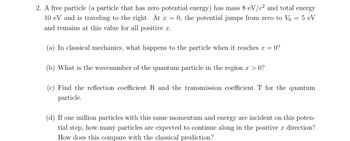Question

Transcribed Image Text:2. A free particle (a particle that has zero potential energy) has mass 8 eV/c² and total energy
10 eV and is traveling to the right. At x = 0, the potential jumps from zero to Vo = 5 eV
and remains at this value for all positive x.
(a) In classical mechanics, what happens to the particle when it reaches x = 0?
(b) What is the wavenumber of the quantum particle in the region x > 0?
(c) Find the reflection coefficient R and the transmission coefficient T for the quantum
particle.
(d) If one million particles with this same momentum and energy are incident on this poten-
tial step, how many particles are expected to continue along in the positive x direction?
How does this compare with the classical prediction?
Expert Solution
This question has been solved!
Explore an expertly crafted, step-by-step solution for a thorough understanding of key concepts.
This is a popular solution
Trending nowThis is a popular solution!
Step by stepSolved in 3 steps with 2 images

Knowledge Booster
Similar questions
- Please asaparrow_forward2. A proton with kinetic energy 1.00 eV is incident on a square potential barrier with height 10.00 eV. If the proton is to have the same transmission probability as an electron of the same energy, what must the width of the barrier be relative to the barrier width encountered by an electron?arrow_forwardA particle is described by a wave function c(x)= Ae-(ax*x), where A and a are real, positive constants. If the value of a is increased, what effect does this have on the particle’s uncertainty in position?Explain.arrow_forward
- 10. A particle is represented (at time t = 0) by the wave function ¥(x,0) = {4(a² ¯ 0, JA(a²-x²), if- a ≤x≤+a otherwise (a) Determine the normalization constant A. (b) What is the expectation value of x (at time t = 0)? d (c) What is the expectation value of p (at time t = 0)? (Note that you cannot get it from p = m² .Why dt not?) (d) Find the expectation value of x². (e) Find the expectation value of p².arrow_forward3. Plane waves and wave packets. In class, we solved the Schrodinger equation for a "free particle" (e.g. when U(x,t) = 0). The correct[solution is (x, t) = Ae(px-Et)/ħ This represents a "plane wave" that exists for all x. However, there is a strange problem with this: if you try to normalize the wave function (determine A by integrating * for all x), you will find an inconsistency (A has to be set equal to 0?). This is because the plane wave stretches to infinity. In order to actually represent a free particle, this solution needs to be handled carefully. Explain in words (and/or diagrams) how we can construct a "wave packet" from the plane wave solution. (Hint 1: consider a superposition of plane waves for a limited range of momentum/energy. Hint 2: have a look at the brief discussion in the middle of pg. 278 and especially pg. 308-309 of the text.)arrow_forwardB7arrow_forward
arrow_back_ios
arrow_forward_ios